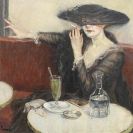
Jean-Louis Forain
1852 Reims
1931 Paris
The French painter, sketcher, caricaturist and graphic artist Jean-Louis Forain was born in Rheims on October 23, 1852. His real name was Louis Henri. In 1863, Forain moved to Paris with his family. In the Louvre, he copied old masters. He made acquaintance with the Parisian history painter Louis Jacquesson de la Chevreuse (1839 – 1903), who gave him his first lessons in drawing.
Thereafter he completed a brief course of study at the École des Beaux Arts in Jean-Léon Gérôme’s (1824 – 1904) studio. However, the artist was dissatisfied with the academic method at the École. Jean-Baptiste Carpeaux (1827 – 75) hired Jean-Louis Forain as his assistant. After he was let go, he lived completely without means.
In the Franco-Prussian War (1870/71), Jean-Louis Forain took part in the defense of the fortress Montrouge. Around the same time, he was a pupil of the caricaturist André Gill (1840 – 85). Jean-Louis Forain sympathized with the Parisian Communards. After the political situation cooled down, he discovered the etchings of Francisco de Goya (1746 – 1828). Later on the artist gained entry into the "club zutiste" and the dinner of the "Vilains Bonshommes". In 1874, his first Salon submission, "Nature Morte à la Bouteille", was rejected. He published his first sketches, in "La Cravache parisienne" among other places. At this time, the influence of the Impressionists was definitive, particularly that of Édouard Manet (1832 – 83) and Edgar Degas (1834 – 1917). At Degas’ invitation, Forain participated four times in Impressionist exhibits between 1879 and 1886. The writer Joris-Karl Huysmans (1848 – 1907) was inspired by Jean-Louis Forain’s work methods, and in 1878 he had the artist portray him in pastels.
In 1889, Forain established the weekly "Le Fifre", which he both wrote and illustrated himself. After Forain primarily etched realistic scenes from 1875 to 1890, he changed later to lithography. Beginning in 1890, he concentrated on nude women at their toilette and milieu studies. In 1891, his cooperation with the journal "Le Figaro" began. However, other papers too wanted Jean-Louis Forain’s barbed representations, which which he became a successor to Honoré Daumier (1808 – 1879). Because of incisive political events, a gradual reorientation of the artist from social to political satire took place. In 1898, Forain started the journal "Psst!" together with Caran d’Ache (1858 – 1909).
Beginning in 1902, he occupied himself above all with religious themes and undertook numerous pilgrimages to Lourdes. Additionally, he broadened his thematic circle to dramatic courtroom scenes. In 1913, a retrospective with 390 pages of Jean-Louis Forain’s works took place in Paris. During World War I, he published his sketches in the papers "Opinion", "Le Figaro" and "Oui", thus showing his true patriotism. After the war, Forain turned gradually away from drawing and back to painting. In 1902, the artist led the Association de la République de Montmartre and the Société des Dessinateurs Humoristes. In 1923, he was elected into the Institut de France and in 1925 to president of the Société National des Beaux Arts.
Jean-Louis Forain died in Paris on July 11, 1931.

Would you like to sell a work by Jean-Louis Forain?
Infos for seller



